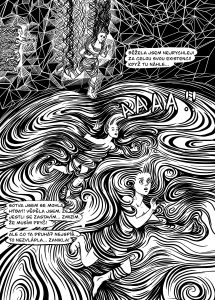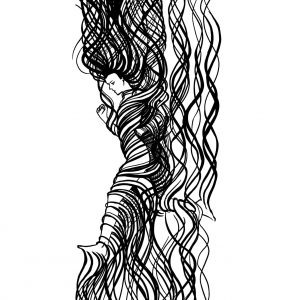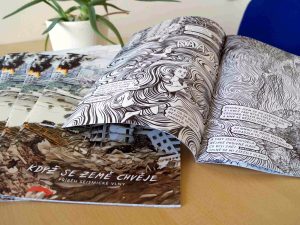Inspiring Stories – Explaining Seismology Through Comics
In this EPEC Inspiring Story, Dr. Petr Brož, a researcher and space communicator at the Institute of Geophysics of the Czech Academy of Sciences, describes how he has developed, together with his colleague Dr. Matěj Machek, comics about seismology for teenagers.
Communicating science can be easy when we target those who are already interested and have a desire to learn something new, but this isn’t always the case. There are many groups which don’t consider scientific knowledge a priority – one of which is teenagers, who are at the transition between childhood and adulthood, and overwhelmed by the many new distractions this brings.
Those who teach know that teenagers can be one of the most difficult groups to attract. To get their attention, one needs to engage and entertain them at the same time, but also communicate to them in a familiar way.
My colleague and I had been thinking about how to overcome these difficulties, as we wanted to ignite a love for Earth sciences even within this hard to reach group. Our solution was to prepare comics explaining some basics of seismology – a field of science which is a research focus of our institute.
The idea to use cartoons as a tool for education is not new. Actually, it has been widely used; just remember ESA’s famous Rosetta and Philae ‘Once upon a time…’ adventure to catch the comet. But as far as we were aware, there was not a dedicated comic for teenagers about seismology, or more precisely, about seismic wave propagation through our planet. So the plan was simple: let’s produce one!

However, our simple plan had one tiny problem. Neither of us had any experience producing comics or an artistic gift to draw. While there was the prospect that we could learn how to make comics, it was clear to us that we would never learn how to transform our fancy ideas into beautiful drawings. Therefore, from the beginning we knew we would need to ask for some professional help. We needed the services of a graphic artist and a scriptwriter. However, to include professionals in the team caused an additional problem, but luckily for us only a minor one. We needed money to hire them!
We started to search for money. Firstly, we asked our institute, but were rejected. There was no will to spend around €8,000 on such a project. We then went one step higher and asked the Czech Academy of Sciences, but ended up with the same result. This time the reason was that there was no money left for the fiscal year. At this point we started searching for external funding. We wrote emails and spoke with many organisations, but all of them gave us negative responses. They liked the idea, but because we were asking in the middle of the year, it was a bad time to get funding. But we weren’t ready to give up. So we tried another option – asking our friends and followers on social media. Surprisingly, this finally worked and our post reached someone willing to help us.

Once the funding was secured, we started to work. First we had to think up a story which would be attractive for readers, while at the same time explaining various processes occurring inside the Earth. It may sound simple, but it was not. How could we take processes occurring deep under our feet which cannot be seen by the naked eye, and turn them into something attractive? This seemed to be the big challenge. During our brainstorming sessions several ideas came out, but it soon became clear that we would need a character to describe these processes to the readers. Who would this be? The selection was simple, the only one who would actually “feel” these deep buried processes: a seismic wave.
But a seismic wave is just energy and therefore cannot speak. So we needed the wave to become a person, and that’s how our seismic “superhero” was born. We sharpened this idea together with the scriptwriter Lucie Lukačovičová, and the rest of the story was actually quite simple to write. We came up with the idea of two kids visiting a seismic monitoring station where they would encounter the P-wave, telling them a story about how she was born and ran through the entire planet. Of course, every good story needs a build-up of tension leading to the grand finale, and our comic is no exception. We needed a dramatic ending that would also educate our readers. We came up with one, but I don’t want to spoil the story, so you’ll have to read the comics to find out the ending!
However, writing the storyline was just part of the project, and to be honest it was the easier part. The real challenges were still ahead of us. How to draw the story, the personified seismic waves (yes, waves, the P-wave has a sister, S-wave, and two brothers, the surface waves), and how to visualize these awkward processes hidden from our sight. To draw the strange behaviour of ductile rocks within the mantle or the formation of the magnetic field within the outer liquid core was not easy. These were the challenges to deal with! We spent many hours with our graphic artist Karolína Kučerová, teaching here the basics of our field before we were able to find a solution. We knew that outreach requires some simplifications of real processes, but we still wanted to be as accurate as possible. Were we successful in that? Again, open the comics and judge for yourself on all the details there.
Once we had all the drawings ready it was a time to finish the dialogues. Before making this comic I assumed that dialogs were written before the drawings, but this project showed me otherwise. There was clearly a need to significantly modify the dialog to match the drawings. I found that much of the text could actually be removed as the drawing helped to describe the scene, and this was a great lesson for me.
So after several months of work, we turned our dream into a real comic printed on shiny paper. This was a relief, but not the end of the story. There were still two important jobs to be done. First was to promote our comic to the public. This is an aspect of science communication which we have a tendency to overlook, but it is one of the most important. Once you finish your project you have to make sure that people know about it. Therefore, we arranged an interview on national TV in which we presented this piece of art, produced a press release, and actively shared information with others who could spread the word. This post is actually part of that effort. Additionally, to support sharing, the comic has been released under the free Creative Commons license.

But what about the second task? The original comic was written in Czech, a language that is used by only 15 million people. This is a relatively small audience, and our ambition for this work is much greater. We want to offer an education tool which anybody can use, and this brings us to the need to translate our work. We recently finished the English version, which you can download here, and this brings the comics to a much wider readership. However, this is not the end, and as not everybody speaks English our aim is to provide translations in many other languages, as many as our finances will allow. So if you are interested in seeing the comic in your own language, and you would be willing to translate, please let us know!
Do you like this story and want more? Browse our archive of EPEC Inspiring Stories and get inspired!

